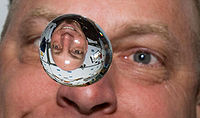
Photo from wikipedia
Abstract A numerical model based on Discrete Element Method (DEM) was developed to simulate the segregation and mixing of cohesive particles in a horizontal rotating drum. The model considered the… Click to show full abstract
Abstract A numerical model based on Discrete Element Method (DEM) was developed to simulate the segregation and mixing of cohesive particles in a horizontal rotating drum. The model considered the cohesive force between particles by simplified Johnson–Kendall–Roberts model. In this study, a granular system comprised of two types of mono-sized spherical particles with different cohesion energy densities was modeled. The results revealed that cohesion and rotation speed had a significant influence on highly cohesive particle behavior in the rotating drum. The mixing of cohesive and non-cohesive particles and also mixing of two types of cohesive particles with or without interparticle cohesive force between them were investigated. It was found that in case of mixing of cohesive and non-cohesive particles, the bed tended to segregate and cohesive particles moved towards the outer layer of the rotating bed. In case of mixing of two types of cohesive particles without interparticle cohesion, complete mixing was not achieved. In case of mixing of highly-cohesive particles with interparticle cohesion, the required time to reach the final mixing state increased. Moreover, it had been observed that cohesion improved the mixing of particles for low-cohesive particles. However, increasing the rotation speed enhanced the mixing of cohesive particles.
Journal Title: Physica A: Statistical Mechanics and its Applications
Year Published: 2019
Link to full text (if available)
Share on Social Media: Sign Up to like & get
recommendations!